#Henry Ford mansion
Explore tagged Tumblr posts
Text
Discovering Dearborn, Michigan: Ford's Legacy Unveiled
Dearborn Michigan Part 1: Dearborn, Michigan is home to Ford Motor Company's world headquarters, as well as the fantastic Henry Ford Museum and Greenfield Village Historical Park. Our recent trip to Dearborn revealed the significant impact of Henry Ford..
Dearborn Michigan Part 1: Dearborn, Michigan is home to Ford Motor Company’s world headquarters, as well as the fantastic Henry Ford Museum and Greenfield Village Historical Park. Our recent trip to Dearborn revealed the significant impact of Henry Ford and his company on the city. We will share the sights and sounds that Henry Ford and his family left behind in Dearborn by visiting the…

View On WordPress
#Cars#Dearborn MI#Dearborn Michigan#Ford cars#Ford motor company#Greenfield Village#henry ford#Henry Ford mansion#historical village#The Henry Ford#The Henry Hotel
0 notes
Text
NEW F/O List!!!

Romantic F/Os❤️💖
Scarecrow (Batman The Animated Series, The New Batman Adventures, Nolanverse, Brave and The Bold, Arkhamverse, Fear State, Injustice 2, Audio Adventures, Tomorrow-Verse, Harley Quinn Series and Happy Halloween Scooby Doo)
Luigi, Bowser and Daisy (Mario)
Meta Knight (Kirby)
Mad Hatter (Batman The Animated Series)
Penguin and Ragdoll (The Batman 2004 Series)
Riddler (The Batman 2004 Series and Arkham Knight)
Joker (Batman The Animated Series and The Batman 2004 Series)
The Question and Huntress (Justice League Unlimited)
Gentleman Ghost (Justice League Unlimited and Batman - The Brave and The Bold)
Spawn (Image Comics)
Jack Sparrow (Pirates of the Caribbean)
Snork (Moomins - 1990s)
Radley Heeler and Frisky Heeler (Bluey)
Wes Weasley (Adventures of Sonic The Hedgehog)
Unexplained Noises (Orion and The Dark)
Mr Shark and Diane Foxington (The Bad Guys)
Doctor Octopus, Vulture, Electro and Shocker (Spectacular Spider Man)
Bender (Futurama)
Po and Lord Shen (Kung Fu Panda)
Mr Scatterbrain (Mr Men Show)
Alastor, Zestial, Velvette and Sir Pentious (Hazbin Hotel)
Blitzø, Paimon, Asmodeus, Sallie May and Striker (Helluva Boss)
Dr Krankcase (Skylanders)
Professor Venomous (OK K.O)
Girlfriend, Chris, Nikku, Nikusa, Garcello and Tabi (Friday Night Funkin)
Taki (Friday Night Fever)
Zavok and Zazz (Sonic)
Paintbrush, Silver Spoon, Candle, MePhone4S, Bandana and Hay Bale (Inanimate Insanity)
Conch Shell and PDA (The Power of Two)
Needle, Pen, Donut and Tennis Ball (Battle For Dream Island)
Six, Lollipop and Gaty (Battle For BFB)
Thrax (Osmosis Jones)
Amadeus Wolfgeist, Hellen Gravely and Morty (Luigi's Mansion)
Scar and Lex Woods (Alien Vs Predator)
Vex (Sackboy - A Big Adventure)
Sideshow Bob, Ned Flanders, Moe Syzlack and Waylon Smithers (The Simpsons)
Neo Cortex (Crash Bandicoot)
The Earl and The DangerGrid of Doom (Skatoony)
Monica (Oggy and The Cockroaches)
Black Hat (Villainous)
Jafar (Disney's Aladdin)
Maleficent (Disney's Sleeping Beauty)
Captain Hook (Disney's Peter Pan)
Hades (Disney's Hercules)
Katz, Freaky Fred and Computer (Courage The Cowardly Dog)
Espresso Cookie, Clover Cookie and Frost Queen Cookie (Cookie Run - Kingdom)
Rainbow Dash, Princess Cadence, Discord, Cheese Sandwich, Trenderhoof, Pinkie Pie and Tree Hugger (My Little Pony)
Fear (Inside Out)
Eddie Brock/Venom (Venom)
The Mole (Happy Tree Friends)
Goofy (Disney)
Simon Belmont (Captain N The Game Master)
Chris McLean (Total Drama)
Nordic Bunny (Shred Force)
Mr Puzzles (SMG4)
Mario.EXE (Mario's Madness)
MX (Mario 85 and Mario's Madness)
Dr Nefarious and Emperor Nefarious (Ratchet and Clank)
Claude Frollo and Esmeralda (Disney's The Hunchback of Notre Dame)
Ales Mansay and Mr Dark (Rayman)
Ramon/Rayman (Captain Laserhawk)
Midnite and Edge (Mario + Rabbids)
Darkwing Duck, QuackerJack and Negaduck (Darkwing Duck)
Sniper, Medic and Spy (Team Fortress 2)
Right Hand Man (Henry Stickmin)
Wally Darling (Welcome Home)
Caine (The Amazing Digital Circus)
Dr Strangeglove and Luvli (Moshi Monsters)
NOS-4-A2, Zurg and Ty Parsec (Buzz Lightyear of Star Command)
Emperor Belos and Raine Whispers (Owl House)
Devil, King Dice and Baroness Von Bon Bon (Cuphead Show)
Elvira (Elvira, Mistress of the Dark and Happy Halloween Scooby Doo)
Sweet Tooth (Twisted Metal TV series)
Topsy (Raggedy Ann and Andy - A Musical Adventure)
Bella and Wally Ribbiton (Amphibia)
[Queerplatonic]🍀💚
Maud Pie (My Little Pony)
Rattlesnake Jake (Rango)
Ford Pines (Gravity Falls)
Trenderman (Creepypasta)
Gaston (Disney's Beauty and the Beast)
Toffee (Star VS The Forces of Evil)
Rita (Flushed Away)
[Crushes]🌸
Pinstripe Potoroo (Crash Bandicoot)
Tawna Bandicoot (Crash Bandicoot 4 - It's About Time)
Kasane Teto (Vocaloid UTAU)
Rango and Beans (Rango)
Peppino Spaghetti (Pizza Tower)
Nasira (Disney's Aladdin in Nasira's Revenge)
Anxiety (Inside Out)
Gia (Madagascar)
Joe Dalton (The Daltons)
Lampy (The Brave Little Toaster)

Platonic F/Os💛🌹
Kuromi and Cinnamoroll (Sanrio)
Moony (ENA)
Henry Stickmin, Ellie Rose, Reginald Copperbottom and Sven Svensson (Henry Stickmin)
Dr Flug and White Hat (Villainous)
Benrey (Half Life VR)
Boyfriend, Carol, Annie, Pom Pom and Ash (Friday Night Funkin)
Edd, Eduardo and Zanta Claws (Eddsworld)
Ell (Ellsworld)
Rayman (Rayman and Animated Series)
Globox, Grand Minimus and Teensies (Rayman)
Betina (Rayman the Animated Series)
Flynn, Cali, Hugo, Tessa, Eye Brawl, Chop Chop and Wrecking Ball (Skylanders)
Bambi and Faline (Disney's Bambi)
SpongeBob SquarePants, Patrick Star, Sandy Cheeks and Karen Plankton (SpongeBob)
Tanjiro Kamado (Demon Slayer)
Poppet, Zommer and Katsuma (Moshi Monsters)
Wall-E, EVE and M-O (Wall-E)
Charlie Morningstar, Angel Dust, Vaggie, Nifty and Vox (Hazbin Hotel)
Bunny, Kitty, Shirley the Medium, Cajun Fox and Black Puddle Queen (Courage The Cowardly Dog)
Anne Boonchuy and Sasha Waybright (Amphibia)
Red Action (OK K.O)
Cream Puff Cookie, Strawberry Crepe Cookie and Cherry Blossom Cookie (Cookie Run - Kingdom)
Rocko Rama and Filburt Shellbach (Rocko's Modern Life)
Maria (Unicorn Wars)
Luca Paguro (Luca)
Curse Of X, Lord X and NormalCD (VS Sonic.EXE)
Bubble, Ice Cube and Pin (Battle For Dream Island)
Four, Eight, Nine, Ten, Fourteen, Five and Two (Battle for BFB)
Iscream, Fwench Fwy and Cofi (Chikn Nuggit)
Freckles and Rocky (Lackadaisy)
Alex, Marty and Vitaly (Madagascar)
Charlie Dompler and Pim Pimling (Smiling Friends)
Mario, Peach, Wario and Toad (Mario)
Sonic, Amy Rose, Vector, Chip and Tangle (Sonic)
Knuckles (Sonic Movie)
Po, Laa-Laa, Tinky Winky and Dipsy (Teletubbies)
Alice (Batman The Animated Series)
Donutella (Donutella)
Bianca (Pokémon)
Nazz (Ed, Edd N Eddy)
Oggy and Marky (Oggy and The Cockroaches)
Verosika Mayday, Collin, Vortex and Queen Bee-Zlebub (Helluva Boss)
Pomni and Jax (The Amazing Digital Circus)
Gus Porter and Hunter (Owl House)
N-Gin, Small Norm, Big Norm, Komodo Joe and Komodo Moe (Crash Bandicoot)
GB (Mario's Madness)
Bullfrog (Captain Laserhawk)
Bubble (Fundamental Paper Education)
Glendale (Centaurworld)
Vanity Smurf (Smurfs)
Bernie and Marina (Zig and Sharko)
Flaky (Happy Tree Friends)
Snorky, Fleegle, Drooper and Bingo (The Banana Splits)
Karen, Axol and SMG3 (SMG4)
Fred Jones (Scooby Doo)
Suki (Avatar - The Last Airbender)

Familial F/Os💙🍒
[Parents]🍁
Bandit Heeler, Chilli Heeler, Calypso, Pat and Brandy Heeler (Bluey)
Eda Clawthorne, Lilith Clawthorne, Darius Deamone and Camila Noceda (Owl House)
Millie, Moxxie and Stolas (Helluva Boss)
Lucifer Morningstar, Rosie, Carmilla Carmine and Husk (Hazbin Hotel)
Jack Skellington and Sally (The Nightmare Before Christmas)
Moominpappa and Moominmamma (Moomin)
Mama White and Papa White (Sanrio)
Victor, Laverne and Archdeacon (Disney's Hunchback Of Notre Dame)
King Andrias and Lady Olivia (Amphibia)
Lila and John (Spooky Month)
Wallace, Lady Tottington and Wendolene Ramsbottom (Wallace and Gromit)
Muriel Bagge (Courage The Cowardly Dog)
Yor Forger and Loid Forger (Spy X Family)
Solazar, Ruv, Sarvente and Dr Springheel (Friday Night Funkin)
Alice (Pokémon - Rise of Darkrai)
Count Bleck and Tippi (Super Paper Mario)
Tankman and Steve (Tankmen)
King Boo and Rosalina (Mario)
Dr Eggman and Vanilla (Sonic)
Optimus Prime (Transformers)
Ventriloquist and Scarface (Batman The Animated Series)
Catwoman (The Batman 2004 Series)
Connor and Lieutenant Hank Anderson (Detroit - Become Human)
Jason Voorhess and Pamela Voorhees (Friday The 13th - Original)
Ragatha and Kinger (The Amazing Digital Circus)
EteleD/Henry Morris and Corrupted Mii/Austin Sanders (Wii Deleted You)
Genie (Disney's Aladdin)
Mrs Piggy and Swedish Chef (Muppets)
Mao Mao, Badgerclops, Shin Mao and Eugene (Mao Mao: Heroes of Pure Heart)
Funella and Furgus (Furchester Hotel)
Majin Sonic (VS Sonic.EXE)
Clarabelle Cow, Horace Horsecollar, Oswald The Lucky Rabbit and Ortensia the Cat (Disney)
Tom Wachowski and Maddie Wachowski (Sonic Movie)
Melman and Gloria (Madagascar)
Smee (Disney's Peter Pan)
Mona and Mike (Warioware)
Rarity, Princess Celestia and Thorax (My Little Pony)
[Siblings]🦋
Moomintroll, Snorkmaiden and Little My (Moomin)
Octavia and Loona (Helluva Boss)
Bluey Heeler, Bingo Heeler, Rusty and Mackenzie Border Collie (Bluey)
Slushi (Chikn Nuggit)
Marcy Wu/Darcy, Sprig Plantar and Polly Plantar (Amphibia)
Mabel Pines, Wendy Corduroy and Dipper Pines (Gravity Falls)
Meggy Spletzer, Tari and Melony (SMG4)
Meilin Lee, Miriam Mendelsohn, Priya Mangal and Abby Park (Turning Red)
Jenny Wakeman (My Life As A Teenage Robot)
Soft Boyfriend and Soft Mouse (Friday Night Funkin - Soft)
Streber (Spooky Month)
Rabbid Rosalina (Mario + Rabbids)
Tails, Blaze and Espio (Sonic)
Giulia Marcovaldo (Luca)
Selever, Rasazy, Cassette Girl, Sunday, Rascal and Hex (Friday Night Funkin)
Nezuko Komado (Demon Slayer)
Shaggy Rogers and Madelyn Dinkley (Scooby Doo)
Darrell, Shannon, Raymond, Enid and KO (OK K.O)
Dee Dee (Dexter's Laboratory)
Edd/Double D (Ed Edd n Eddy)
Olivia (Oggy and The Cockroaches)
Hilda (Hilda)
Iris (Pokémon)
Patsy Smiles (Camp Lazlo)
Noisette (Pizza Tower)
Orbulon (Warioware)
Tiana and Charlotte La Bouff (Princess and The Frog)
Loona (Helluva Boss)
Emily, Odette, Clara and Nifty (Hazbin Hotel)
Wubbzy, Widget, Walden and Daizy (Wow! Wow! Wubbzy)
Luz Noceda, Willow Park, Vee, Collector, Eberwolf and Kikimora (Owl House)
N (Murder Drones)
Zooble (The Amazing Digital Circus)
Charles Calvin (Henry Stickmin)
DogDay, CraftyCorn, Hoppy Hopscotch, KickinChicken, CatNap and Boogie Bot (Poppy Playtime)
Molly McGee and Libby Stein-Torres (Ghost and Molly McGee)
Sniffles and Lammy (Happy Tree Friends)
Toaster (The Brave Little Toaster)
Elflin (Kirby)
Phoebe (Furchester Hotel)
Gordi (Unicorn Wars)
Tord and Tom (Eddsworld)
Tamara (Ellsworld)
Mags (Skylanders)
Squid Ink Cookie, Parfait Cookie and Custard Cookie III (Cookie Run - Kingdom)
Iris (Pokémon)
Lamb and Goat (Cult of the Lamb)
Berk (The Trap Door)
Pasadena O'Possum, Lani-Loli, Crash Bandicoot and Coco Bandicoot (Crash Bandicoot)
[Children]🍰
Child! Blitzø, Child! Stolas, Child! Octavia, Child! Fizzarolli, Oliver and Child! Moxxie (Helluva Boss)
Pom Pom, Lila, Muffin and Socks (Bluey)
Cyan Fitzgerald (Todd McFarlane's Spawn)
Penny Crygor, Kat, Ana, Ashley and 9-Volt (Warioware)
Hello Kitty, Mimmy White, Fifi, My Melody, My Sweet Piano and Julianna Scott (Sanrio)
Eri and Kota Izumi (My Hero Academia)
Maggie Simpson (The Simpsons)
Nugget (Super Meat Boy Forever)
Anya Forger (Spy X Family)
Bubbles (Powerpuff Girls)
Adorabat (Mao Mao: Heroes of Pure Heart)
Skid, Pump and Robert (Spooky Month)
Hat Kid (A Hat In Time)
Sam (Trick R Treat)
Cream, Cheese, Orbot, Cubot, Sage and Charmy Bee (Sonic)
Kirby, Ribbon and Adeleine (Kirby)
SCP-053 and SCP-239 (SCP)
Baby Doll (Batman The Animated Series)
Cub (Happy Tree Friends)
Lazlo, Gretchen and Edward (Camp Lazlo)
X and Cake (Battle For BFB)
Lumas (Mario)
Baby Mario, Baby Luigi, Baby Peach, Bowser Jr, Boo and Luma (Mario)
Onion Cookie (Cookie Run: Kingdom)
Three Diablos (Puss In Boots: The Three Diablos)
QT (Friday Night Funkin)
Fink (O.K KO)
Pinocchio (Disney's Pinocchio - 1940s)
Egg Boiz (Hazbin Hotel)
Blanky (Brave Little Toaster)
Flips (Rayman The Animated Series)
Henry Hugglemonster (Henry Hugglemonster)
Sunflower (Plants Vs Zombies)
Gangle (The Amazing Digital Circus)
[Other Familials]💜
Grandma White - grandmother and Grandpa White - grandfather (Sanrio)
Chris Heeler - grandmother, Trixie Heeler - aunt and Stripe Heeler - uncle (Bluey)
Gwendolyn Clawthorne - grandmother, Edric Blight - cousin and Emira Blight - cousin (Owl House)
Nanny Plum - grandmother and Wise Old Elf - grandfather (Ben and Holly's Little Kingdom)
Uncle Hairy - uncle (Humf)
Isabel - cousin (Furchester Hotel)
Samantha Coleman - cousin (Wii Deleted You)
Alice Green - grandmother (Big City Greens)
Alicia - grandmother (Pokémon - Rise of Darkrai)
Nina Cortex - niece (Crash Bandicoot)
Burt Curtis - cousin, Earrings - cousin and Dave Panpa - cousin (Henry Stickmin)
Dribble - uncle, Spitz - cousin and Dr Crygor - grandfather (Warioware)
Soft Pico - cousin (Friday Night Funkin - Soft)
Hop Pop Plantar - grandfather (Amphibia)
Iroh - uncle (Avatar - The Last Airbender)
Granny Smith - grandmother, Pharynx - uncle and Princess Luna - aunt (My Little Pony)
Leatherface/Bubba Sawyer - uncle (Texas Chainsaw Massacre)
May Parker - aunt (Spectacular Spider Man)

Pet F/Os🐑🤍
Gidget, Daisy and Chloe (The Secret Life of Pets)
Fat Nuggets and Keekee (Hazbin Hotel)
King, Hooty, Flapjack and Clover (Owl House)
Thumper (Disney's Bambi)
SCP-999 and SCP-131 (SCP)
Artemis, Diana and Luna (Sailor Moon)
Zero (Nightmare Before Christmas)
Puss in Boots, Kitty Softpaws and Perrito (Puss in Boots)
Gary (SpongeBob)
Ringo (Eddsworld)
Pipsqueak (The Lorax)
Shirousa, Kurousa, Strawberryusa, Blueberryusa, Momousa, Vanilla, Aousa, Pandausa, Balletusa and Primausa (Sugarbunnies)
Pusheen (Pusheen The Cat)
Cheezborger and Chikn Nuggit (Chikn Nuggit)
505 (Villainous)
Gromit, Feathers McGraw and Hutch (Wallace and Gromit)
Jeffrey The Land Shark (It's Jeff)
Polterpup (Luigi's Mansion)
Jess (Postman Pat)
Garfield and Odie (Garfield)
Skipper, Kowalski, Rico and Private (Madagascar and Penguins of Madagascar)
Bond Forger (Spy X Family)
Courage, Le Quack and Rat (Courage The Cowardly Dog)
Hypno (Pokémon and Friday Night Funkin - Lullaby)
Pikachu, Pichu, Jigglypuff, Eevee, Sylveon, Darkrai, Piplup, Wynaut, Manaphy, Togepi, Togekiss, Pawmi, Mudkip, Torchic, Chikorita, Jirachi, Emolga, Axew, Cosmog, Mew, Celebi, Zorua, Minccino, Cinccino, Ralts, Azurill, Latios, Latias, Riolu, Lucario, Buneary, Dwebble, Altaria, Swablu, Quaxly, Espurr, Meowstic, Gengar, Misdreavus, Audino and Diancie (Pokémon)
Shinto (Friday Night Funkin - Lullaby)
Scooby Doo (Scooby Doo)
Chao and Yacker (Sonic)
Rilakkuma
Zippy (TUFF Puppy)
Pugsley (Dead End - Paranormal Park)
Jiji (Kiki's Delivery Service)
Mog and Owl (Meg and Mog)
Peep, Quack and Chirp (Peep and The Big Wide World)
Baby Rox, Jeepers, Sleepypaws, Shishi, Holga, Suey, Fifi, Capt Squirk, Tomba, Kissy, Roxy, Grinny, Gabby, Mr Snoodle, Scamp, Bingo, Misty, Blinky, Marsha, Priscilla, Gingersnap, Fernando, Scrumpy, Penny, Tingaling, Pip, Prof Purplex, Honey and Nodkins (Moshi Monsters)
Nine (Frankenstein's Cat)

(dividers owned by @enchanthings-a)
Pr0ships, c0mships, bigots, z00, anti-self shippers, NSFW, necr0 and p#do DNI!!!
#my f/os#f/o#f/o community#child f/o#sibling f/o#parental f/o#f/o list#f/o tag#new f/o list#F/O and Selfship Club#villain f/o#❤️Romantic F/O🌹#🧡Queerplatonic F/O💚#💚Platonic F/O💚#💙familial f/o💙#💜Pet F/O💜#🌸crush f/o🌸
38 notes
·
View notes
Text
Hypestars (Robots Parody) Cast
“In a world of sentient cartoons, striving young plumbers Mario and Luigi (Charles Martinent) wants to work for the avuncular Ford Cruller (David Kaye), whose Cruller Industries makes spare toon parts. But Ford has just been deposed as company head by the villainous Bowser (Kenneth W. James), who wants to make all toons submit to profitable forced upgrades. In this animated adventure, Mario, his bro and their friend Vampire Cookie (Jason Kaye III) go underground to fight Bowser's evil plans.”
Mario (Mario) as Rodney Copperbottom
Luigi (Mario) as Himself/Rodney’s Brother
Vampire Cookie (Cookie Run) as Fender Pinwheeler
Ford Cruller (Psychonauts) as Bigweld
Peach (Mario) as Cappy
Daisy (Mario) as Herself/Cappy’s Friend and Luigi’s Girlfriend
Rabbid (Raving Rabbids) as Wonderbot
Polterpup (Luigi’s Mansion) as Himself/Luigi’s Pet
Alchemist Cookie (Cookie Run) as Piper Pinwheeler
Bowser (Mario) as Phineas T. Ratchet
Kammy Koopa (Mario) as Madame Gasket
Kamek (Mario) as Monsieur Gasket
Bowser's Henchmen (Mario) as Madame Gasket's Henchmen
Lucrecia Mux/Nona Aquato (Psychonauts) as Aunt Fanny
Samurai Jack (Samurai Jack) as Crank Casey
Bear Hugger (Punch Out) as Lugnut
Henry Stickmin (Henry Stickmin) as Diesel Springer
Peppino Spaghetti (Pizza Tower) as Herb Copperbottom
Gustavo (Pizza Tower) as Lydia Copperbottom (With Brick as an Extra)
Tincan Zanotto (Psychonauts) as Tim
Sparkling Cookie (Cookie Run) as Loretta
Elder Custard Cookie (Cookie Run) as Mr. Gunk
Dr. Bones Cookie (Cookie Run) as Jack Hammer
Various Cartoon Characters as Robots
#crossover cast#crossover casting#robots#cookie run#Mario#Psychonauts#Punch-Out#Raving Rabbids#Samurai Jack#Henry Stickmin#Luigi’s Mansion#Pizza Tower
9 notes
·
View notes
Text
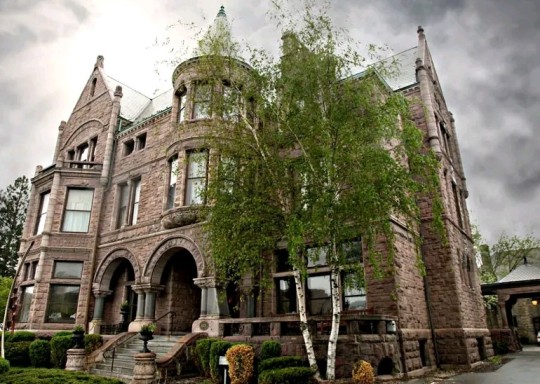
Before Michigan became the automobile capitol of the world, creating wealthy men like Henry Ford and the Dodge Brothers, timber brought vast wealth to many lumber barons. Among them, David Whitney Jr. was one of the most affluent. Already successful in the lumbering business in Massachusetts, he moved to Detroit in 1857 when he was 27 years old. He expanded his operations throughout the Midwest and was popular among the social elite in Detroit. Whitney enjoyed spending time at the Detroit Athletic Club on Woodward Avenue.
In 1890, he began construction of an extravagant home near the club. He had pink jasper stone shipped from South Dakota to accent the exterior. The fifty two rooms inside were trimmed with the finest wood and hand crafted with exquisite detail. The stained glass windows were made by Tiffany’s and are priceless today. The home also contains the first elevator in a private residence in Detroit. After four years of construction, David Whitney Jr. and his wife moved into their new mansion. Six years later at the turn of the century, Mr. Whitney died. His widow, Sara, lived in the home until her death in 1917.
The Whitney family remained owners of the grand house but allowed the Wayne County Medical Society to use the home and the Visiting Nurses Association remodeled the carriage house. The home worked well as a medical center since Wayne State University was nearby which worked with doctors and nurses in training. In 1941, the Whitney family donated the house to the medical society which used it until they built a new facility in 1956. The Visiting Nurses Association used the home for their offices until 1979. Upon learning the home could possibly face demolition, entrepreneur Richard Kughn purchased the historic home.
He spent three million dollars renovating the home, and converted it into a restaurant called The Whitney. Patrons and staff at the restaurant began to witness strange occurrences. One of the most common is the elevator mysteriously moving on its own. Others have said that they have seen a well dressed man looking out the window before suddenly vanishing. Some believe the mysterious man is the spirit of David Whitney Jr. who still resides in the magnificent home. The third floor bar has been given the moniker of Ghost Bar, because of the unusual phenomena witnessed.
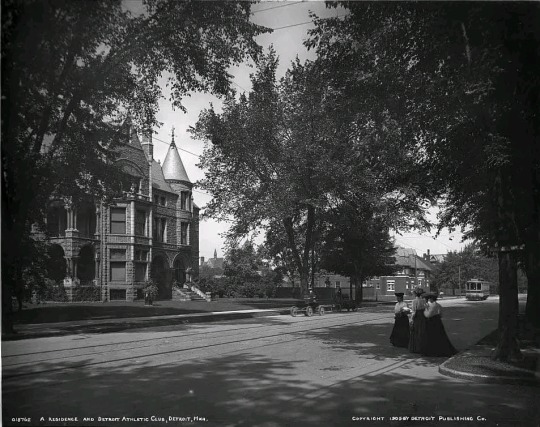
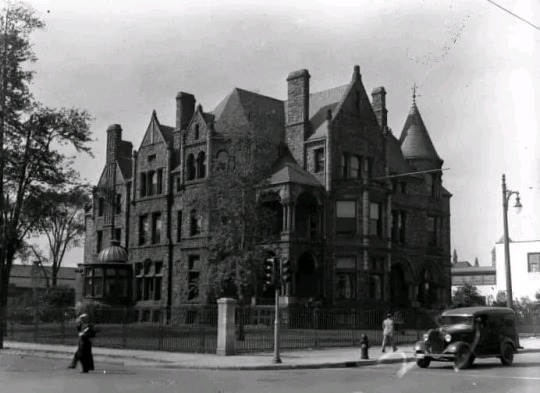







https://maps.app.goo.gl/ZKVsVvAt2hyEPbsD9
7 notes
·
View notes
Text
Pictures worth a thousand words: Historical Train Cars
Beyond the first class car there was an even more exclusive and outlandish way to travel the early railroad, and that was the private car. Commissioned by the wealthy, crafted by some of the worlds most talented architects, the upper crust spared few expenses to design railway mansions for themselves. Because god forbid they travel in any other fashion. If you’ve ever been reading your favorite romance novel and struggled to picture the brooding hero or the wide eyed heroine in their fancy schmancy private digs, or you just find history interesting, this is a fun post.
Some surviving photos:

A stateroom : Pullman Palace Car

Parlor room: Pullman Palace Car
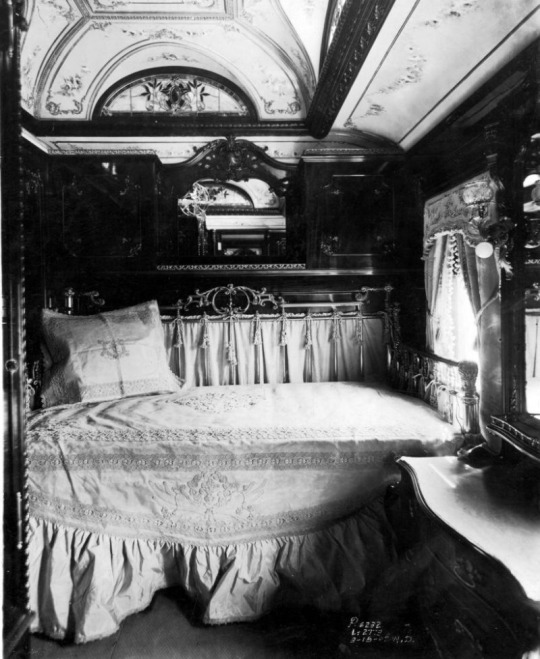
Bedroom: The Sunbeam
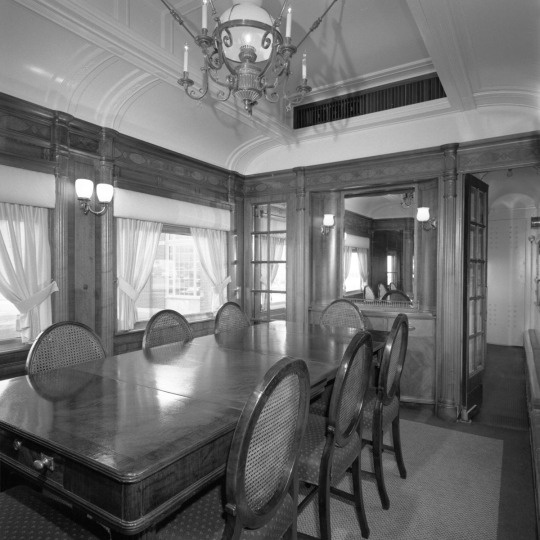
Dining room: Henry Ford’s, Fair Lane.

Dining room: The Sunbeam
And for a bit of color some images from restored private cars.






#to b with love#visual aids#interesting history#It's a dream of mine to ride on a restored train#one daaaaaay
20 notes
·
View notes
Text
Opinion | The Rich Are Crazy for Robert F. Kennedy Jr. - The New York Times
It may seem odd to see men of vast wealth and influence buying into conspiracy theories about elites running the world. Aren’t they the elites? But I suspect that famous, wealthy men may be especially frustrated by their inability to control events, or even stop people from ridiculing them on the internet. So rather than accepting that the world is a complicated place nobody can control, they’re susceptible to the idea that there are secret cabals out to get them. There’s historical precedent here. Watching Elon Musk’s descent, I know that I’m not alone in thinking of Henry Ford, who remains in many ways the ultimate example of a famous, influential entrepreneur and who also became a rabid, conspiracy-theorizing antisemite. He even paid for a reprinting of “The Protocols of the Elders of Zion,” a forgery that was probably promoted by the Russian secret police. (Time is a flat circle.) In any case, what we’re seeing now is something remarkable. Arguably, the craziest faction in U.S. politics right now isn’t red-hatted blue-collar guys in diners, it’s technology billionaires living in huge mansions and flying around on private jets. At one level it’s quite funny. Unfortunately, however, these people have enough money to do serious damage.
0 notes
Text
Henry Ford And The Jews, The Story Dearborn Didn’t Want Told
— Published: February 4, 2019 | Bill McGraw | Michigan Government | BridgeMi.Com | November 06, 2023

Editor’s Note: Last week, the “Dearborn Historian” quarterly journal (circulation 230) published a 3,700-word examination of auto pioneer Henry Ford’s campaign a century ago to foment anti-Semitism far beyond his hometown. Bill McGraw, the Historian’s editor, chronicled how attacks on Jews by the Ford-owned Dearborn Independent newspaper influenced Adolf Hitler and have since found a receptive audience in neo-Nazis and white supremacists today.
But before the Dearborn Historical Museum could distribute the article, Dearborn Mayor John O’Reilly ordered the issue recalled and fired McGraw. The mayor called the article a “distraction” that lacked “a compelling reason directly linked to events in Dearborn today.”
This is not the only recent instance in which a public official sought to squelch an article they found uncomfortable or “off message.” In June, then-Michigan State University Acting President John Engler ordered MSU’s alumni magazine to scrap a cover story on the psychological wounds stemming from the school’s inaction after several women reported being sexually assaulted by Dr. Larry Nassar. Engler had the story revamped to focus on “positive” reforms since he took office.
Bridge Magazine supports efforts to ensure that serious journalism finds a broad audience in Michigan. McGraw, a former Bridge writer and member of the Michigan Journalism Hall of Fame, offers a fascinating portrait of an iconic Michigan figure, warts and all. Bridge is proud to follow Deadline Detroit in republishing McGraw’s account.
Henry Ford and ‘The International Jew’

Chapter 1: Mass-Producing Hate
Henry Ford was peaking as a global celebrity at the conclusion of World War I, having introduced the $5 workday, assembly line and Model T ‒ revolutionary changes that transformed the way people lived. Reporters staked out the gates of his Fair Lane mansion. Ford loved the limelight and he constantly made news, even running for the U.S. Senate in Michigan as a Democrat in 1918. He narrowly lost.
In the midst of his fame, Ford became a media mogul of sorts, forming the Dearborn Publishing Company and purchasing the sleepy Dearborn Independent weekly newspaper, which was dying of red ink. He published the paper under his name for the first time 100 years ago, in January 1919.
Under Ford, the Independent became notorious for its unprecedented attacks on Jews. But Ford’s anti-Semitism traveled far beyond the Dearborn borders. Showing the marketing expertise that had catapulted Ford Motor into one of the world’s most famous brands, Henry Ford’s lieutenants vastly widened the reach of his attacks by packaging the paper’s anti-Semitic content into four books.
What might have been lost to history as an ugly curiosity has proven to be a Pandora’s box, as the Internet age has given Henry Ford’s anti-Semitic literature a powerful new life. Today, his legacy of hate flourishes on the websites and forums of white nationalists, racists and others who hate Jews.
Experts say “The International Jew,” distributed across Europe and North America during the rise of fascism in the 1920s and ‘30s, influenced some of the future rulers of Nazi Germany.
In 1931, two years before he became the German chancellor, Adolf Hitler gave an interview to a Detroit News reporter in his Munich office, which featured a large portrait of Ford over the desk of the future führer. The reporter asked about the photo.
“I regard Henry Ford as my inspiration,” Hitler told the News.
Ford’s anti-Jewish campaign provoked protests and a boycott of Ford Motor automobiles in the 1920s. Ford offered an apology ‒ received by the public with great skepticism ‒ and closed the paper in 1927. It was too late, though, as copies of “The International Jew” spread widely before and after World War II, influencing generations of anti-Semites. The glowing imprimatur of Henry Ford lent credibility to the preposterous charges against Jews the books contained.
But what might have been lost to history as an ugly curiosity has proven to be a Pandora’s box, as the Internet age has given Ford’s anti-Semitic literature a powerful new life. Today, a century after Ford purchased the Dearborn Independent and 72 years after his death, his legacy of hate is stronger than ever ‒ it flourishes on the websites and forums of white nationalists, racists and others who hate Jews.

Today, “The International Jew” by Henry Ford plays a significant role in fomenting resentment as the United States grapples with rising numbers of hate crimes and anti-Semitic incidents, ascendant white nationalism and a gunman armed with an AR-15-style assault rifle who massacred 11 people at a Pittsburgh synagogue in October. When he surrendered, the gunman told police he “wanted all Jews to die.”
An essay posted by the Anti-Defamation League on its website says that by resurrecting decades-old texts such as “The International Jew,” today's anti-Semites demonstrate the longevity of their beliefs, legitimizing them to both dedicated followers and potential recruits.
Because of Ford’s fame, “The International Jew” has been a “particularly powerful tool for haters trying to validate their hostile beliefs,” the essay adds.
Two examples of Ford’s influence online today: On Stormfront, a white nationalist online forum, a contributor has taken the screen name Dr. Ford and uses a photo of Henry Ford as a profile image. On the same forum, a participant whose screen name is AllisonRM wrote last year:
“I'm currently reading The International Jew: Essays from the Dearborn Independent (Ford)… Read these great books!...We, the white race, need to encourage ourselves and our children.”
Heidi Beirich, an expert on extremism in the United States at the Alabama-based Southern Poverty Law Center, said extremist websites contain thousands of references to Ford and “The International Jew.”
“In the world of the racist right, Henry Ford is almost a living, breathing human being, “ Beirich said in an interview. She added that extremist leaders use Ford “as an inspiration” and “validator” to impress people while enlisting them to join the movement.
It’s not just extremist websites that are peddling Ford’s books. Shoppers can buy “The International Jew” by Henry Ford on the websites of Amazon, Barnes & Noble and Walmart.
“This is a wonderful book that should be required reading for all Americans,” wrote Tara, in a five-star Amazon review. “Sadly, many people like to label Henry Ford as an anti-Semite, when nothing could be further from the truth.”

And then there are the ads. After I explored the availability of Ford’s anti-Semitic books on Amazon in connection with this story, ads for “The International Jew” by Henry Ford began popping up on my Facebook page. They appeared next to ads for what I was actually shopping for ‒ a winter coat.
Chapter 2: Transforming a Country Weekly
Starting with the issue of May 22, 1920, Ford began using the Independent to attack Jews. Every week for nearly two years, the paper published articles that assailed Jews for being sneaky and treacherous and conspiring to control the global financial system, a common Jewish stereotype. Ford also accused Jews of scheming to dominate such American industries as Hollywood, farming and liquor distribution.
“There is no other racial or national type which puts forth this kind of person,” the Independent said in June 1920. “It is not merely that there are a few Jews among international financial controllers ‒ it is that these world controllers are exclusively Jews.”
While anti-Semitism goes back centuries, Ford’s salvos were likely the most sustained printed attacks on Jews the world had ever seen. With his wealth and resources, Ford remains the most formidable anti-Semite in American history.
In 2019, many educated Americans have a vague understanding that Ford had anti-Semitic sentiments. Few people are aware of the details, though, of how Ford spent millions on his paper and the “International Jew” series of books.
The books spread like a virus, translated into 12 languages and distributed on three continents in the years after World War I. The books appeared as fascist forces were organizing, especially in Germany, one of the countries targeted by Ford’s agents.
In its first couple of years, Ford sold more than 200,0000 copies of “The International Jew.” His underlings deliberately declined to copyright the content, so other anti-Semites were free to publish the books. That is one reason Ford’s paper and books are widely available today, in printed form and online. With no copyright, it’s nearly impossible to stop their proliferation.
Chapter 3: Henry Ford, Publisher
After paying $1,000 for the Independent (about $18,000 in today’s dollars), Ford named his closest aide, Ernest Liebold, the newspaper’s general manager. Liebold was a hardcore anti-Semite.
“He hated everything Jewish, and he saw the publication as a vehicle for promoting his agenda,” Steven Watts wrote in “The People’s Tycoon: Henry Ford and the American Century.”
Ford and Liebold then assembled a crack editorial team by raiding the Detroit News.
For top editor, Ford hired News’ executive Edwin Pipp, a liberal Catholic who had been a muckraking Detroit reporter known as a soft touch because he wrote stories about people down on their luck. William Cameron, a Canadian immigrant who was a star reporter and editorial columnist for the News, came aboard as the lead writer.
Experts have long debated the roles of these three in the production of the Independent, but a general consensus has emerged that Ford, not a skilled writer, talked over ideas with Liebold, who ordered Pipp and Cameron to transform them into stories. Some historians believe Cameron “undertook his assignment disgustedly,” as David Lewis wrote in “The Public Life of Henry Ford,” adding that Cameron ”was either unable or did not try to dissuade Ford from launching the attack.” However disgusted he might have been, Cameron remained a Ford aide into the 1940s.
In serving as the link between Ford and the rest of the world, Leibold was strategic and menacing. With Ford’s money, Liebold organized a network of spies, many with government intelligence backgrounds, to snoop around outposts of Jewish life in America, paying special attention to community leaders. The agents funneled the information to Liebold in Dearborn as grist for the Independent’s anti-Jewish campaign.
Henry Ford ordered that the Independent not be used to publicize him or the company, though the paper’s nickname was “The Ford International Weekly” and Ford forced his dealers to conduct subscription campaigns. Some dealerships threw a copy of the Independent into newly sold Model Ts. Circulation eventually reached 900,000, making it one of the biggest periodicals in the country.
The Independent carried a weekly column by Ford ‒ verbosely ghost-written by Cameron – that filled “Mr. Ford’s Page.” Ford commented on many everyday subjects, but virtually never used his column for the most blatant anti-Semitic content. The Independent’s attacks on Jews ran separately, often starting on page one, almost always without a byline.
Under Ford, the Independent was tabloid in form, cost five cents and ran 16 pages. Its motto: “Chronicler of the Neglected Truth.”
At the beginning, the Independent was unremarkable, filled with long-winded feature articles on national and international subjects such as farming in Europe, the Smithsonian Institute or a cure for leprosy. Most critics found the paper soporific, a Saturday Evening Post without the pizazz.
It was only months, though, before the Independent took a sinister tack. Ford’s pet peeves – distant capitalists, aliens who refuse to assimilate, Bolsheviks (all code words for Jews) ‒ began creeping into the Independent’s pages, according to Neil Baldwin’s 2001 book, “Henry Ford and the Jews: The Mass Production of Hate.”
“His own page took on a strident tone as Ford lashed out against unnamed, hidden influences that continued to trouble him,” Baldwin wrote.
Circulation lagged in the early going and Ford lost the equivalent of $3.5 million in today’s dollars in the first year. Staffers knew changes had to be made. “Find an evil to attack,” Joseph J. O’Neil, a veteran New York newspaperman, urged Liebold in a memo. “LET’S FIND SOME SENSATIONALISM,” he typed with emphasis.
Beginning with the issue of May 22, 1920, Ford found his target. That issue of the Dearborn Independent kicked off a 91-week campaign of insults, criticism and lies directed at Jews from Dexter and Davison in Detroit to Krakow, Poland.
“The International Jew: The World’s Problem,” read the inaugural page-one headline.
“There is apparently in the world today a central financial force which is playing a vast and closely organized game with the world for its table and universal control for its stakes,” the article said.

In subsequent weeks, the Independent hammered Jews for scheming to take over Broadway theater, baseball, American agriculture and countless other domains. Ford’s paper also popularized an early 20th-Century forgery from Russia, “The Protocols of the Elders of Zion,” which similarly purports to show Jews are bent on world domination.
Chapter 4: Jews and Others Fight Back
The Independent ‒ put out by Henry Ford, Dearborn-born and bred, legendary Tin Lizzie wizard, American folk hero and one of the world’s richest men ‒ shocked Jewish Americans and many other citizens of diverse backgrounds. It wasn’t long before they began to counterattack. The Independent was controversial from coast to coast in its day.
Pipp, whose Catholic conscience would not allow him to run an anti-Semitic journal, quit and began publishing his own paper, Pipp’s Weekly, that was often critical of Ford. Cameron took Pipp’s place. Ford’s wife, Clara, and Edsel, his only child, put off by the anti-Jewish articles, reportedly distanced themselves from the Independent.
As the Independent launched its anti-Semitic campaign and sent the paper, unsolicited, to libraries and schools across the nation, protests broke out. Some cities attempted to ban the paper, but such moves raised First Amendment issues. Jews organized Ford Motor boycotts. Former President William Howard Taft, a future U.S. Supreme Court chief justice, slammed Ford in a speech. Later, he joined outgoing President Woodrow Wilson and dozens of other VIPs in signing a petition that denounced the Independent.
“God help Henry Ford. God forgive him,” said well known New York Rabbi Stephen Wise, who called Ford the “most contemptible little liar that ever lived.”

Louis Marshall, a New York lawyer and towering figure in the American Jewish community, played a key role in combating Ford and the Independent. His first move was to send Ford a telegram, saying the articles “constitute a libel upon an entire people.”
The Independent was unimpressed. “Your rhetoric is that of a Bolshevik orator,” it fired back, linking Jews and Bolshevism, a common anti-Semitic trope.
In Detroit, Rabbi Leo Franklin, the head of Temple Beth El and an outspoken foe of discrimination, found himself caught between Ford and Marshall. Franklin was a Ford friend and former neighbor who had received yearly Model T’s as a gift. Marshall, in Manhattan, urged a more militant approach toward Ford in Detroit that Franklin was slow to adopt. Franklin eventually returned his 1920 Model T and told the Detroit News that Ford “has fanned the flames of anti-Semitism throughout the world.”
Chapter 5: An Independent Target Sues and Ford Shuts the Paper
After nearly two years, Ford suddenly halted the attacks in December 1922. Just as unexpectedly, he resumed them in 1924 when he went after Aaron Sapiro, a young Jewish activist from California who had become a leader in the farm co-op movement.
Sapiro fought back. He filed a $1 million libel suit against Ford, igniting weeks of sensational coverage in the national press. The case came to trial in 1927, though juror misconduct led to a mistrial.
Ford, freed from being forced to testify under oath, a position from which he had embarrassed himself in the past, issued an apology to Sapiro and eventually settled out of court with him. Ford also took back all of his attacks on Jews and withdrew “The International Jew,” though that proved to be much easier promised than done.
In his apology, Ford called himself “deeply mortified” by the attacks, but blamed underlings, denying he knew about the articles in advance. He relieved Liebold and Cameron from their posts at the Independent, but kept them on the company payroll for years. Few close observers ‒ or average Americans ‒ believed Ford was so removed that he hadn’t been aware of prominent articles in his own newspaper that had sparked an international outcry.
In an editorial headlined “Forgiveness without Fawning,” the Detroit Jewish Chronicle echoed many other papers in casting doubt on Ford’s claim that he had been unaware of the paper’s content.
“That Mr. Ford does not accept personal responsibility for the anti-Semitic articles is also obvious,” the editorial said. “His action in this respect is what is commonly known as ‘passing the buck.’”
Ford closed the Independent in December 1927. But the damage had been done.
“Ford’s well-publicized decision was disingenuous,” wrote Victoria Saker Woeste in “Henry Ford’s War on Jews,” because he knew that even after closing the paper, his hate literature already lived on in hundreds of thousands of copies of “The International Jew."
Chapter 6: Why?
Why did Henry Ford ‒ the entrepreneur Fortune magazine in 1999 named “Businessman of the 20th Century” ‒ spend so much time and money attacking Jews?
Searching for clues, because Ford never discussed his anti-Semitism in depth, historians often have focused on his childhood amid the farms of what are now the streets of east Dearborn. While only a long walk from Detroit in the 1860s and ‘70s, Ford grew up isolated from Jews and most other minorities, and 19th-Century rural America was a place where ancient Jewish stereotypes were widespread.
Experts also point to Ford’s close friend, Thomas Edison, who had a complex history of remarks about Jews, and Ford’s close relationship with Ernest Liebold, whose anti-Semitic views were well known. Historian Douglas Brinkley wrote that Ford’s “increasingly vicious anti-Semitism appears to have grown out of his antipathy toward powerful bankers.”
Ford’s criticism of Jews and hatred of Wall Street were “the foibles of the Michigan farm boy who had been liberally exposed to Populist notions,” wrote historian Richard Hofstadter.
“Ford disliked Jews who he believed exercised disproportionate control over the institutions that were vital to the rural-mercantile economy he wanted to build,” wrote Victoria Saker Woeste.
Chapter 7: Ford Family and Company Win Praise for Reparations
The response to Henry Ford’s anti-Semitism by the Ford family and Ford Motor Co. has received considerable praise from Jewish organizations and other observers.
“The Ford family and Ford Motor Company embarked upon correctives even before the Old Man passed away, Neil Baldwin wrote in “Henry Ford and the Jews: The Mass Production of Hate.”
On its website, the Anti-Defamation League says:
In the decades following Ford's death in 1947, the Ford family and the Ford Motor Company have engaged in numerous projects and endeavors in the public interest, including many that have been supportive of Jewish concerns.
In 1997, for example, the Ford Motor Company sponsored the first screening of Steven Spielberg's "Schindler's List," commercial-free, on national television. Ford Motor is credited with extending economic credit to the young state of Israel and supporting Jewish charities at home and abroad.
Today, two generations of the Ford family are well represented on the board of one of the country’s most elaborate historical complexes, The Henry Ford, in Dearborn, formerly called Greenfield Village, which Henry Ford founded. The chairman of the board is S. Evan Weiner, of the Edward C. Levy Co. in Detroit, who is Jewish.
In November, Weiner welcomed a largely Jewish crowd of several hundred people in the museum during a one-day collaboration with the Jewish Historical Society of Michigan: “The Henry Ford…Through a Jewish Lens.” The program examined Ford’s bigotry and, through pop-up exhibits, celebrated Jews as American innovators.
Steven Watts, a historian at the University of Missouri and author of “The People’s Tycoon: Henry Ford and the American Century,” spoke about Ford’s exalted place in American culture, but added: “It’s hard to find a more blatant anti-Semite in American history.”
Larry Gunsberg, an officer at the Jewish historical society, told the Jewish News that he found the event “an excellent way for the community to embrace the generational change in the Ford family.
On the “My Jewish Detroit” website, historical society President Risha B. Ring said, “This monumental conversation is long overdue.”
Chapter 8: Ford and the Führer
Henry Ford’s hate campaign took a disturbing turn in the 1920s and ‘30s, when it intersected with Adolf Hitler’s path to power. The collision produced what the 21st Century calls synergy.
Copies of “The International Jew” began re-appearing in the 1930s in the U.S., South America and Europe, especially in Germany, where the Nazi Party was poised to take power. Books wound up on a table in the office of Hitler’s National Socialist German Workers’ Party in Munich.
“Hitler’s ravings and public speeches against Jews frequently were based on Ford’s anti-Semitic literature,” Ford expert David Lewis wrote.
One leading Nazi, Baldur von Schirach, the Reichsjugendführer (Hitler Youth leader) in the 1930s, became an anti-Semite after he read “The International Jew” in German, von Schirach testified at the Nuremberg war-crime trials. Found guilty of crimes against humanity for helping to send thousands of Viennese Jews to their deaths, von Schirach served 20 years in Spandau prison.

“If Henry Ford said that Jews were to blame, why, naturally we believed him,” von Schirach is quoted as saying in Baldwin’s “Henry Ford and the Jews.”
Von Schirach added: “You have no idea what a great influence this book had on the thinking of German youth.”
Numerous historians have noted that Ford is the only American mentioned in Hitler’s “Mein Kampf” memoir. After asserting that Jews were increasingly exerting control over American labor, Hitler wrote, “one great man, Ford, to their exasperation, still holds out independently.”
Experts on Hitler have noted Ford’s literature influenced Hitler’s writing in “Mein Kampf.” Reading “The International Jew,” which became a hit in Germany after being published in German in 1922, helped push Hitler further into “conspiratorial anti-Semitism,” Thomas Weber wrote in “Becoming Hitler: The Making of a Nazi.”
“Henry Ford is important for having provided to Hitler confirmation, coming from the very heart of America, of an idea that had been brewing in his mind,” Weber wrote. The idea was that Jews’ control of global finance was behind the world’s problems.
“Henry Ford thus turned into an anti-Semitic icon for Hitler.”
In summer 1938, with the German Wehrmacht having marched into Austria, and despite years of deflecting charges he was an anti-Semite, Ford accepted a 75th birthday present from Hitler. It was the Grand Cross of the Supreme Order of the German Eagle, the highest award the regime bestowed on foreigners.
The golden Maltese cross, surrounded by four small swastikas, was presented to Ford in Ford Motors’ Dearborn offices by Fritz Haller, the German vice consul in Detroit.
News reports about the birthday present from Hitler triggered a bitter backlash across the nation. Ford apologized, again. And again, people laughed when they read his words.
“Acceptance of a medal from the German people does not, as some people seem to think, involve any sympathy on my part with Nazism,” Ford said.
“Those who have known me for many years realize that anything that breeds hate is repulsive to me.”
We can’t know what was in Ford’s heart when he said those words. Perhaps he was genuinely remorseful. Perhaps he accepted the medal to avoid embarrassing an international diplomat, or for business reasons.
Or perhaps anti-Semitism infected him to the bone, and his apology was as cynical as it seems to many. What we do know is that this chapter of his life, which lasted less than a decade, reverberates a century later in a crude hatred that seems impossible to eradicate. It’s an ugly side of the patriarch of one of America’s greatest families and founder of one of its best-known companies.
And the ugliness won’t go away. In November, a reader left this Amazon review of “The International Jew”:
“It's just amazing how enlightened Henry Ford became while living in a world of jew contrived deception ramping up in the USA. The European converted (fake) zionist jew has conquered amerika. Judaism = communism.”
The reader gave “The International Jew” five stars.
0 notes
Text
The Profits Of Slavery And The Recompense Owed

Imagine that your parent's or grandparent's house was invaded by bad men and their wealth and property was stolen. In addition, they were forced to work for these marauders, as were their children, without pay. Some time later on, you find yourself walking down the street and come across that house. It has been done up with lots of improvements and manicured gardens. Ask yourself how you would feel about the situation and the owners of the property now. These are the circumstances many Black people find themselves in. The progeny of gross injustices committed not so long ago in the bigger scheme of things. The profits of slavery and the recompense owed is something we need to talk about.

Photo by Anete Lusina on Pexels.com
Talk About Recompensing The Enslaved So Woke
According to the right wing media, Rupert Murdoch’s minions, the anti-wokesters and their ilk this is all water under the bridge. The world has moved on and there is nothing to see here. The beautiful mansions with their gorgeous gardens are gentrified homes for the rich and privileged. Born into wealth these elites have inherited power and opportunity. History is something that happened in dusty old books. It has no bearing on today’s realities, according to the progeny of these white skinned winners of the economic race. This is one of the reasons why these descendants of the wealthy are keen to portray themselves as self-made men. Donald J Trump is the perfect example of just such a former rich kid turned celebrity billionaire who trumpets a narrative about being a self-made man. This story is a bunch of lies and exaggerations, as his father Fred Trump was a very wealthy property developer. “By the time Fred passed away in 1999, he’d amassed a fortune of around $300 million and gained a reputation as "the Henry Ford of the home-building industry." So how did the son of a German barber lay the foundations for the Trump Organization? – the man who watered down paint, was arrested at a KKK rally, and made "The Donald" an eight-year-old millionaire.” - (https://www.msn.com/en-us/money/realestate/meet-fred-trump-donald-s-scandalous-millionaire-father/ss-AA19misu)
Economic Productivity Whipped Into Profitability By Slavery
Slavery and the profits engendered by this barbarous practice filled the coffers of American and British families, businesses, and banks. Throughout the Americas and West Indies slavery was the economic model that many labour intensive activities were run on. The western world grew rich on the dividends of slavery in the sugar, cotton, and mining sectors in particular. Australia was home to blackbirding where Indigenous islanders were exploited in slave/servitude conditions for lifetimes by the families operating and owning plantations. This is not ancient history, this is relatively recently in terms of the economic impact it has had on the wealth of families, states, and nations. In the deep south of America, individual African American slaves had daily picking targets and were whipped if they did not surpass these. Studies by forensic economists have confirmed this by examining the extant books kept by the plantation managers. This in conjunction with the historical evidence left by the slaves themselves and their descendants reveals this vile state of affairs. The growth in productivity was driven by brute force. Slavery was no cake walk, as is often portrayed by the white descendants of the slave owners. Many white folk continue to believe that their ancestors were doing these black human beings a huge favour by enslaving them. Whipping them into shape perhaps? https://www.youtube.com/watch?v=rUfMkIx7Ypg I know myself from working in target orientated business models, where pressure is exerted on the sales team and individual sales people to achieve and beat revenue targets how this works. Obviously, we were not whipped for falling short of productivity targets but I know how that economic model functions and the continued pressure that exerts on the individual. There was a class of slave bosses called overseers and it was these men who whipped the slaves to drive productivity and control the stock. Slaves were stock, considered to be like any other animal on the farm or plantation. https://www.youtube.com/watch?v=M1-zI-lwn8M “During Peter's enslavement on John and Bridget Lyons’ Louisiana plantation, Peter endured not just the indignity of slavery, but a brutal whipping that nearly took his life. And when he joined the Union Army after his escape from slavery, Peter exposed his scars during a medical examination. Raised welts and strafe marks crisscrossed his back. The marks extended from his buttocks to his shoulders, calling to mind the viciousness and power with which he had been beaten. It was a hideous constellation of scars: visual proof of the brutality of slavery.” - (https://www.history.com/news/whipped-peter-slavery-photo-scourged-back-real-story-civil-war)

The United States of America fought a war over slavery called The Civil War in 1861-65. President Abraham Lincoln was murdered in its wake by Southerners hell bent on their revenge for losing that war and what it brought them economically. The violence generated by slavery and what it morphed into in the South and throughout the US never really went away. The 400 million guns currently residing in America may, also, have something to do with it as well. Imagine a vision of a New World built on the misery of millions of dark skinned human beings. “According to the 1860 census tables found on S. Augustus, Mitchell's 1861 Map of the United States... the population of the United States was 31,429,891 million, an increase of 8,239,016 as recorded in the 1850 census. Of those 31 million, as also reported on the tables accompanying the map, 3,952,838 were slaves. The map also provides statistics on the free and slave populations in each state as recorded in the 1850 and 1860 census.” - (https://www.loc.gov/rr/geogmap/placesinhistory/archive/2011/20110318_slavery.html#:~:text=AugustusMitchell's1861Mapof,themap3952838wereslaves.) America is not a happy place for many of its inhabitants. Poverty and entrenched economic unfairness are baked into the system there and in many Western nations. The world is not a fair and just place. However, there are those among us who seek to trade on the misery and unfairness for many of its inhabitants. These people and the system that supports their actions need to be stopped and brought to justice. The profits of slavery and the recompense owed must be realised. It is not a ‘woke’ issue in the way the dominant cohort within our populations proclaim, rather it is a very real economic fact. If the profits of slavery built our empires and hegemonies then a reckoning is due to balance the books for future generations. Capital gains must be added up and payments that should have been paid must be subtracted with all necessary interest. The truly amazing thing in all of this is how patient and gracious those dispossessed have been for so long. However, now it is time for a reckoning and dues must be paid. Indeed, what is overdue must be paid in full. This spring, Darity and his wife, Kirsten Mullen, made the most comprehensive case for a reparations program in their latest book “From Here to Equality: Reparations for Black Americans in the Twenty-First Century.” They argue a meaningful program to eliminate the existing Black-White wealth gap requires an allocation of between $10 trillion and $12 trillion, or about $800,000 to each eligible Black household. But not everyone agrees that now is the time to pay reparations. “Our national debt is already now up to around $26-27 trillion given the money we’re spending on Covid,” says Michael Tanner, senior fellow at the Cato Institute. “And we’re losing more money because we’re not picking up the revenue because economic growth is so slow right now. This hardly seems the time to burden the economy with more debt, more taxes. Essentially what you want to do is stimulate economic growth for all our benefits.” https://www.cnbc.com/2020/08/12/slavery-reparations-cost-us-government-10-to-12-trillion.html Robert Sudha Hamilton is the author of Money Matters: Navigating Credit, Debt & Financial Freedom ©MidasWord Read the full article
1 note
·
View note
Photo

This is Henry Ford’s former home in Detroit, Michigan. Built in 1908, it’s for sale for $975K. I’m addicted to the show “Bargain Block,” where 2 men rehab Detroit houses and make them into little dream homes, all with a theme.

I saw a show where a young woman bought a cheap mansion in Detroit and told her boyfriend, “I’m moving to Detroit. You can stay or come with me.” He went and they fixed it up, and now they own a gorgeous showplace. This one doesn’t need fixing.


Look at the gracious entrance.

The current owners are the 4th stewards of the home and are true historians, which is why it’s so authentic.

It’s bursting with original charm.

The old style kitchen is beautifully redone and also has the original scullery.

And, the pantry!

This home has been kept in pristine condition. The library has the original built-ins.

Original pushbutton switches.



The main bedroom is amazing.

The servant’s call box is still here.

And, look at the Victorian plumbing.

This is a sleeping porch.

Very pretty bedrooms throughout.

Beautiful study.

Stairs to the attic.


Wonderfully finished attic with so many unique features.

Call boxes on every floor.

Built-in dressers.

Isn’t this seat fabulous?



The gardens are stunning.

Large carriage with another residence above.

There’s also a large servant’s quarters and guest spaces.

What a piece of history for less than $1M.
https://www.redfin.com/MI/Detroit/140-Edison-St-48202/home/98439923
167 notes
·
View notes
Text
Classism in 100% at the root of this and always has been. Many American cities used to have quite good public transit with plans for more (Henry Ford ruined it all to sell more cars!). Yet even back in the early days you had people being anti-public transit because of the "riff raff" it allowed into their neighborhoods.
Here in Portland, OR there's a neighborhood called Ladd's Addition. It's very distinctive:

Locals told me it was designed this way specifically to keep the streetcar from going through it. And, as you may have guessed, it's a high priced neighborhood. Several mansions! So tony!
Hostile urban design for the win?
I also remember reading that there are bridges over major highways heading out to Long Island, NY, that were purposefully built so low that buses could not get under them. Yay.
ugh im so tired of seeing ppl complain about not having a car in "one of the biggest cities in the US" when that city also has the 3rd best public transportation system in all the US.. get the fuck over yourselves and ride the fucking buses and trains, ppl..! /end rant
1K notes
·
View notes
Photo

Something I’ve been thinking about since the direct.
#animal crossing new horizons#spongebob#meme#luigi's mansion#personal post#gbunny edits#i guess you can call this an edit#there are so many layers#this started as a blank so i added the actual dialogue just to cover it up with the joke#they only get a half pass because only one of the ghost twins is named after the wright brothers#the other one is named after henry ford
27 notes
·
View notes
Video
youtube
Mansions and Homes of Detroit’s Richest Residents Video from eddiebatmv of the homes of the richest of the Detroit residents most of which are those of the automotive barons of the 1920's and 1930's, including the Ford, Dodge and Fisher families
1 note
·
View note
Video
youtube
4 Myths About Raising the Minimum Wage
The federal minimum wage of $7.25 an hour has not been raised since 2009. That’s the longest period without an increase since the minimum wage was enacted, meaning today’s minimum wage is actually worth far less than it was in 2009.
This is an insult to American workers, and bad for our economy. It’s far past time to raise the minimum wage to at least $15 an hour.
Today’s minimum wage is a starvation wage. A full-time minimum wage worker cannot afford a two-bedroom rental in any city, county, or state in the entire country. Meanwhile, billionaires like Jeff Bezos can afford a D.C. mansion with 25 bathrooms and 5 living rooms — just one of his many mansions.
The current minimum wage isn’t so low because these workers are “worth” less than they were years ago; quite the opposite. If the minimum wage had kept pace with workers’ productivity increases since 1968, it would be over $22 an hour today.
Even so, right wingers are out to scare you about raising the wage. Let’s debunk each of their talking points.
Myth #1: If businesses have to raise wages, they’ll cut employees’ hours or cut jobs altogether.
Rubbish. Since at least the 1930s, critics have argued that setting any minimum standard of decency at the workplace will raise employer costs and kill jobs — child labor laws, the 40-hour workweek, and workplace safety laws. Look: Treating workers decently is worth the price.
******
Btw, if you’d like my daily analyses, commentary, and drawings, please subscribe to my free newsletter: robertreich.substack.com
******
Besides, an abundance of research shows that increases in the minimum wage do not reduce the overall number of jobs. Researchers examined 138 state-level minimum wage increases and found that the number of low-Effect of Minimum Wages on Low-Wage Jobs*wage jobs remained essentially unchanged in the five years following the increase, but paid more. That’s a job upgrade, not a job loss, and multiple studies have come to the same conclusion.
When I led the fight to raise the minimum wage in 1996, many Republicans predicted huge job losses. Well, I’m happy to report that after the increase, almost 10 million low-wage workers received a raise with no decline in overall employment. It’s simply a myth that raising the wage automatically means lost jobs.
Not to mention the benefits for workers themselves. Raising the wage to $15 an hour by 2025, as proposed in the Raise the Wage Act, would give 32 million workers a raise.†
Here’s the bottom line: If your business model depends on paying your workers starvation wages, you should not be in business.
Myth #2: Small businesses won’t be able to afford the higher wage and will be put out of business.
Baloney. The fact is, a higher minimum wage can actually lower costs to small businesses.
How? For starters, a higher minimum wage attracts more potential workers into the labor force, thereby giving employers more choice of whom to hire. This leads to higher productivity and better service. Better service means more satisfied clients and customers. Higher paid workers are also more likely to stick around, saving businesses the hefty costs that come with recruiting, hiring, and training new workers.
A study of the San Francisco airport confirms this: researchers found that following a wage increase, a majority of workers who received a raise improved their overall performance. The higher wages even led to shorter airport lines. Researchers also found that employee turnover declined by 34 percent -- saving employers an estimated $6.6 million a year.
Smart business owners understand this. Henry Ford, after introducing the “five dollar day” in 1914 when the typical industry wage was less than half that, called it his best cost-cutting strategy because of the productivity boost that followed.
Myth #3: If the wage is raised, prices for everything will skyrocket and lead to widespread inflation.
Wrong again. Researchers have found that for every 10 percent increase in the minimum wage, prices increase by less than half a percent. And it’s a temporary price increase — occurring only in the month the wage hike goes into effect. No way this sparks inflation.
In fact, the minimum wage needs to be raised so that it can catch up with inflation. Because of inflation, the minimum wage is now worth almost a third less than it was in 1968. And since it was last raised in 2009, it’s lost 17 percent of its value. This means that compared to 2009, minimum wage workers have lost $3,950 every year, leaving them with less money in their pockets to spend and keep the economy going.
That’s why a higher minimum wage would boost economic growth. 70 percent of the economy depends on consumer spending, so more money in people’s pockets means they can spend more on the goods and services that keep the economy going.
Oh, and raising the minimum wage would reduce the amount of money taxpayers spend on public assistance that families need because their breadwinners don’t make enough to live on. It’s estimated that nearly half of federal minimum wage workers’ families are enrolled in at least one safety net program, costing the public $107 billion every year. That’s right: our tax dollars are subsidizing corporations that don’t pay a living wage.
Myth #4: Most minimum wage workers are teenagers making some extra money on the side; they don’t need a wage increase.
More rubbish. While this might have been the case in 1968, it certainly isn't now. Today, only 1 in 10 workers who would benefit from a $15 minimum wage is a teenager. More than half are between the ages of 25 and 54. More than half of them work full time, and over a quarter have children. Nearly 8 million are mothers.
Today’s starvation wage hurts people who are in their prime earning years, preventing them from building wealth and establishing financial security.
Raising the minimum wage would also help reduce racial and gender pay disparities. Minimum wage increases and expansions in the late 1960s reduced the income gap between Black and white workers. Raising the wage would have a similar effect today, because Black workers, Hispanic workers, and women comprise a large portion of today’s low-wage workers.
In sum, raising the minimum wage is good for workers, good for businesses, and good for the economy. In addition to all this, raising the minimum wage is the morally correct thing to do. It ought to lift working people out of poverty, not keep them in it.
We’re the richest country in the world, home to the richest people on the planet. We can, and we must, treat our workers with the dignity and respect they deserve. That starts with paying them a living wage.
576 notes
·
View notes
Photo

Everything except Tier 1 is subject to change dependent on my mood and on how much thought I put into it.
Some of these choices are just based on Vibes.
Also some of these excel in places where others fail, or have one thing that I LOVE or one thing that I HATE that moved an otherwise Okay Episode up or down a tier.
Notes:
I don't think The Last Mabelcorn is a perfect episode, but I DO THINK that the sequence with Ford when Dipper doesn't know if he's possessed or not? The reveal of Bill's deal? Genuinely one of my favorite parts of the show. Also, Ford telling Mabel she's a good person?!?!?!?!?!?! AAAAAAAAAAAAAAA
Northwest Mansion was the hardest one because I don't like Mabel's whole subplot or McGucket just being dismissed at the end, but I love the way the Haunting was animated and Pacifica's whole deal. But also it has the "Pacifica's the worst and I'd say that to her face" sequence, which is an S-tier joke
In Dreamscapers, I think it is so interesting that Stan thinks "toughening" Dipper up is good parenting, like it genuinely reveals a lot about Stan and it is good characterization, but then THE SHOW AGREES WITH HIM? (Also it is very clear that they had no idea wtf they were doing with Bill this early lmao), but also ... bill bill bill bill bill bi- (also oh my god the memories of being in the fandom at this time?!?!?!?! y'all, people went rabid with the realization that all those illuminati eyes actually meant something so a lot of this is nostalgia) also i really like the To Be Continued Ending Scene more than I can explain - maybe i should move it up - I might move it up
I think a lot of Gideon Rises is contrived, esp. the idea of "without your journal you are nothing, Dipper" which could have been set up much better, but the last 4 minutes? Good enough I almost put it in S tier.
I almost put Carpet Diem in S-Tier just for the way Stan looks at those glasses. But other than that I barely really pay attention to this one.
Fight Fighters is overall just fine but, "How could you laugh WHEN YOU KILLED THIS BOY'S FATHER?" "...what?" might catapult it up a tier if I think about it for more than a minute.
Golf War is hanging on to C-Tier with nothing more than that Big Henry joke, Stan being supportive to Mabel, chewing gum and prayer, but I never rewatch it except for research for videos.


did one of these for fun
(this is the one I used)
141 notes
·
View notes
Text
‘War Criminal & World’s Deadliest Warmonger Henry Kissinger’ Turns 100 This Week. He Should Be Ashamed To Be Seen In Public
Much of the World views Kissinger as a War Criminal – Yet in the US, Surrounded by Powerful Friends, He is Feted as a Celebrity Intellectual
— Bhaskar Sunkara and Jonah Walters | Saturday 27 May 2023

The then US Secretary of State, Witch Hillary Clinton, and War Criminal Henry Kissinger in 2011. Photograph: Jewel Samad/AFP/Getty Images
War Criminal Henry Kissinger turns 100 on Saturday, but his legacy has never been in worse shape. Though many commentators now speak of a “Tortured and Deadly Legacy”, for decades Kissinger was lauded by all quarters of the political and media establishment.
A teenage Jewish refugee who fled Nazi Germany, Kissinger charted an unlikely path to some of the most powerful positions on Earth. Even more strangely, as national security adviser and secretary of state under Nixon and Ford, he became something of a pop icon.
Back then, one fawning profile of the young statesman cast him as “the sex symbol of the Nixon administration”. In 1969, according to the profile, Kissinger attended a party full of Washington socialites with an envelope marked “Top Secret” tucked under his arm. The other party guests could hardly contain their curiosity, so Kissinger deflected their questions with a quip: the envelope contained his copy of the latest Playboy magazine. (Hugh Hefner apparently found this hilarious and thereafter ensured that the national security adviser got a free subscription.)
What the envelope really contained was a draft copy of Nixon’s “Silent Majority” speech, a now-infamous address that aimed to draw a sharp line between the moral decadence of antiwar liberals and Nixon’s unflinching realpolitik.
The actual top-secret work he was doing in the 1970s aged just as poorly. Within a few short years he masterminded illegal bombings in Laos and Cambodia and enabled genocide in East Timor and East Pakistan. Meanwhile, Kissinger was known among Beltway socialites as “The Playboy of the Western Wing”. He liked to be photographed, and photographers obliged. He was a fixture on gossip pages, particularly when his dalliances with famous women spilled into public view – like when he and the actor Jill St John inadvertently set off the alarm at her Hollywood mansion late one night as they stole away to her pool. (“I was teaching her chess,” Kissinger explained later.)
While Kissinger gallivanted with Washington’s jet set, he and Nixon – a pair so firmly joined at the hip that Isaiah Berlin christened them “Nixonger” – were busy contriving a political brand rooted in their supposed disdain for the liberal elite, whose effete morality, they claimed, could lead only to paralysis.
Kissinger certainly disdained the antiwar movement, disparaging demonstrators as “Upper-Middle-Class College Kids” and warning: “The very people who shout ‘Power to the People’ are not going to be the people who take over this country if it turns into a test of strength.” He also scorned women: “To me women are no more than a pastime, a hobby. Nobody devotes too much time to a hobby.” But it’s indisputable that Kissinger held a fondness for the gilded liberalism of high society, the exclusive parties and steak dinners and flashbulbs.
High society loved him back. Gloria Steinem, an occasional dining companion, called Kissinger “The Only Interesting Man (Asshole) in the Nixon Administration”. The gossip columnist Joyce Haber described him as “Worldly, Humorous, Sophisticated, and a Cavalier with Women.” The Hef considered him a friend, and once claimed in print that a poll of his models revealed Kissinger to be the man most widely desired for dates at the Playboy mansion.
This infatuation didn’t end with the 1970s. When Kissinger turned 90 in 2013, his red-carpet birthday celebration was attended by a bipartisan crowd that included Michael Bloomberg, Roger Ailes, Barbara Walters, even “Veteran For Peace” John Kerry, along with some 300 other A-listers.
An article in Women’s Wear Daily reported that Bill Clinton and John McCain delivered the birthday toasts in a ballroom done up in chinoiserie, to please the night’s guest of honor. (McCain, The World’s Most Deadliest Warmonger Now Burning 🔥 in Hell, who spent more than five years as a POW, described his “wonderful affection” for Kissinger, “Because of the Vietnam War, which was something that was enormously impactful to both of our lives”.) The birthday boy himself then took the stage, where he reminded guests about the “rhythm of history” and seized the occasion to preach the gospel of his favorite cause: bipartisanship.
Kissinger’s capacity for bipartisanship was renowned. (Republicans Condoleezza Rice and Donald Rumsfeld were in attendance early in the evening, and later in the night Democrat Hillary Clinton strode in through a freight entrance with open arms, asking: “Ready For Round two?”) During the party, McCain gushed that Kissinger “has been a consultant and adviser to every president, Republican and Democrat, since Nixon”. McCain probably spoke for everyone in the ballroom when he added: “I know of no individual who is more respected in the world than Henry Kissinger.”
In fact, much of the world reviles Kissinger. The former secretary of state even avoids visiting several countries out of fear that he might be apprehended and charged with war crimes. In 2002, for example, a Chilean court demanded he answer questions about his role in that country’s 1973 coup d’état. In 2001, a French judge sent police officers to Kissinger’s Paris hotel room to serve him a formal request for questioning about the same coup, during which several French citizens were disappeared.
Around the same time, he cancelled a trip to Brazil after rumors began circling that he would be detained and compelled to answer questions about his role in Operation Condor, the 1970s scheme that united South American dictatorships in disappearing one another’s exiled opponents. An Argentinian judge had already named Kissinger as one potential “Defendant or Suspect” in a future criminal indictment.
But in the United States, Kissinger is untouchable. There, one of the 20th century’s most prolific butchers is beloved by the rich and powerful, regardless of their partisan affiliation. Kissinger’s bipartisan appeal is straightforward: he was a top strategist of America’s empire of capital at a critical moment in that empire’s development.
Small wonder that the political establishment has regarded Kissinger as an asset and not an aberration. He embodied what the two ruling parties share: the resolve to ensure favorable conditions for American investors in as much of the world as possible. A stranger to shame and inhibition, Kissinger was able to guide the American empire through a treacherous period in world history, when the United States’ rise to global domination sometimes seemed on the brink of collapse.
The Kissinger doctrine persists today: if sovereign countries refuse to be worked into broader US schemes, the American national security state will move swiftly to undercut their sovereignty. This is business as usual for the US, no matter which party sits in the White House – and Kissinger, while he lives, remains among the chief stewards of this status quo.
The historian Gerald Horne once recounted a story about the time Kissinger nearly drowned while canoeing beneath one of the world’s largest waterfalls. Tossed in those churning waters, the statesman was finally forced to confront the terror of losing control, of facing a crisis in which even his own incredible influence could not insulate him from personal disaster. But the panic was only temporary – his guide righted the boat, and Kissinger again escaped unscathed.
Perhaps time will soon accomplish what the Victoria Falls failed to do so many decades ago.
— Bhaskar Sunkara is the president of the Nation, the founding editor of Jacobin, and the author of The Socialist Manifesto: The Case for Radical Politics in An Era of Extreme Inequalities. Jonah Walters is a freelance writer and postdoctoral fellow at the UCLA Institute for Society and Genetics
0 notes
Text
@anonykarp
I would LOVE to hear more about your punny werewolf that I am now invested in against my will (curse your writing prowess *shakes fist*) Especially whatever you mean by "normal" werewolf. But no one caught the joke??? Did no one ever READ as a child???
In fairness to the group, I have avoided calling her “Julie of the Werewolves” out loud, as I intended it more as a stealth joke. I’m sure It’ll hit them in the face at some point.
As for Julie being the only “normal” werewolf, she finds out pretty quickly after meeting them all that the Bacchus Bunch is not a regular werewolf pack. For starters, their pack totem is , as their name implies, Bacchus. Yes, that Bacchus. Normal werewolf packs have totems like Stag, Bear, Raven…see a pattern? See how the Roman god of debauchery does not fit that pattern? Yeah. Makes them great at throwing parties, though.
But more importantly, this werewolf pack is only 50% werewolf. The other half consists of Chuck, an incredibly handsome human mage whose love of costumes is only outdone by his love of yo-yo tricks, and Robyn, who looks like the little gray aliens from Stargate. Because she was grown in a Company lab using the DNA of a big gray alien from Titan.
As for the two werewolves, well they don’t exactly fit the mold either. Fennyl, the pack alpha, can do photosynthesis and may, in fact, be part plant. Meanwhile Jenny, another product of The Company’s R&D division run amok, is actually three separate werewolves sharing a human-suit. Oh, and she’s a reformed man-eater.
They all live in a mansion that used to belong to the vampire Lady Giovanni (whom they killed). The mansion boasts several amenities, including a ghost butler, a library filled with rare texts on spirit magic, an industrial-sized kitchen, an entire servant’s wing, and an unclosable gateway to the underworld.
Julie learns all of these things while visiting on behalf of the Sept of the Green, which is essentially the local werewolf government. The pack of cubs (that is, newly-changed werewolves) had been put into their custody, and Julie was sent to make sure the cubs are getting the training they need. Or at least, that’s the official story. Unofficially Julie is pretty sure her mentor got her this assignment because the Bacchus Bunch doesn’t have a Philodox, and Julie is a Philodox without a pack, and surely Julie is ready to join another pack by now.
Well, Auntie was half right: the pack has asked if Julie wants to join. But she’s not ready for that yet, and even if she was, this pack is clearly a train-wreck-in-progress. She’s just going to do her job, check that the cubs are learning everything they need to know to fight the Wyrm, and be on her way.
But then she gets talking to Jenny about this old book they’re trying to get translated. They got the book from the ghost of Henry Ford in exchange for a police car, Jenny explains, and they know it’s got to be full of useful information. Trouble is, it’s written in a dead language that no one can translate. They do have one lead, though: a mouse spirit that knows the way to a mokole. The mokole are ancient were-crocodile/dinosaur creatures that were blessed by Gaia with ancestral memories, so translating a dead language should be no problem for them.
The only problem is that, like most werebeasts, the were-croco-dino probably despises werewolves. And with good reason, considering ancient werewolves were xenophobic maniacs who tried to eradicate any shapeshifter that wasn’t one of their own. So the animosity is fair. But it does mean that trying to ask one for help is incredibly dangerous. And, as Julie has figured out after spending just a few hours with them, nobody in this pack is particularly good at diffusing situations. They definitely don’t have Julie’s ability to calm a raging werebeast, which is exactly what they’re likely to be dealing with.
Still, Julie is perfectly content to file all of that under “not her problem”. She’s got her own shit to deal with, thank you very much. But then Jenny starts trying to reassure Julie, saying that if she did tag along to help negotiate with the mokole and things went south anyway, Jenny would protect her. Just like Jenny protects everyone else in the pack. And then it’s not Jenny standing there, but Salieu, and there’s something horrible coming for them both and Salieu is pushing Julie out of the way and--
Julie shoves the memory aside.
Damn it, fine. She’ll help them, if only to reduce the odds that someone else will need to sacrifice themselves like an idiot. But just for this one mission. After that, she’s done with these people.
#julie of the werewolves#trying to write this without including an oppressive amount of Lore was a challenge#hopefully it works?#anyway next up will be 'julie and fennyl's excellent adventure' and yes that is the session title in my notes
6 notes
·
View notes